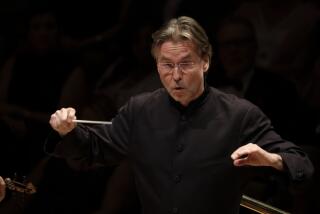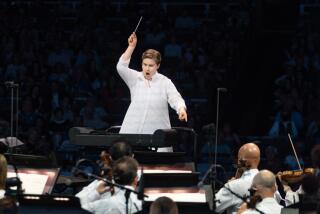Review: Pianist Garrick Ohlsson packs Disney Hall for a thrilling, sometimes punishing, performance
On Sunday evening, pianist Garrick Ohlsson performed an all-Beethoven recital at Walt Disney Concert Hall featuring four of his popular “name” sonatas: the “Pathétique,” “Appassionata,” “Waldstein” and “Moonlight.”
These early and middle sonatas show Beethoven in his revolutionary, heaven-storming mode. They are among the most difficult works in a pianist’s repertoire. For one recital, it offered almost too much to process — a barrage of virtuoso brilliance and proto-Romantic and Impressionistic poetry that was at once thrilling and exhausting.
Ohlsson’s beautifully proportioned account of the Piano Sonata No. 8 (“Pathétique”) seemed a harbinger of 19th century Romanticism from its solemn opening page. In the demanding outer movements, Ohlsson missed notes and smudged a phrase or two, but these minor slips seemed part of the all-too-human character of his earthy and ethereal reading, from the moody opening Allegro to the extremely agitated Rondo finale. The central Adagio, an affecting love song, was rendered with supple restraint.
SIGN UP for the free Essential Arts & Culture newsletter »
Fully warmed up, the 68-year-old virtuoso delivered a powerfully controlled account of the groundbreaking Piano Sonata No. 23 (“Appassionata”). The work perhaps demands a freer temperament than Ohlsson’s, but his attention to detail provided dividends. The pianist conveyed plenty of passion in the precision of the hymn-like slow movement and in Beethoven’s racing, defiantly self-conscious dance in the coda, which came off as bizarre as ever. Ohlsson’s blunt percussive attacks, as in the furious dissonant pounding on a diminished-seventh chord that leads into the explosive finale, as well as his occasional brusqueness in the opening and closing Allegros, summoned the self-absorbed, in-your-face Beethoven that continues to challenge and bewilder us, as it did listeners in 1805.
After intermission, the tragic fury of the “Appassionata” gave way to another revolutionary work, the sunnier Piano Sonata No. 21 (“Waldstein”). The score’s soft and softer passages, with subdued climaxes, showed Ohlsson’s virtuosity in a quieter mode. If the transitional slow movement into the joyous finale felt a bit sketchy, Ohlsson made up for it by employing the sensitive acoustics of Disney Hall to make the score’s visceral, vibrating bass line felt throughout the work.
In the famous whispered opening of the Piano Sonata No. 14 (“Moonlight”), Ohlsson’s concentrated pianissimo and poetically rendered overlapping harmonies suggested an early instance of impressionism. Ohlsson found repose in the central Allegretto and sustained Beethoven’s inexorable forward sweep in the demonic finale.
After so much complex, furious virtuosity, the pianist’s many fans (the hall was packed) brought Ohlsson back for an apt encore: “Clair de Lune” from Debussy’s “Suite bergamasque,” stretched for every drop of poetry, but a welcome change from all the angst that had come before.

The Los Angeles Philharmonic’s YOLA holds a 10th anniversary tour with stops in Northridge, Visalia, Fresno and Oakland.
Follow The Times’ arts team @culturemonster.
ALSO
The next new Finnish star conductor takes the stand in Disney Hall
Noh theater: The world’s oldest stage tradition is popping up everywhere
‘Hamilton’ star Leslie Odom Jr. finds the music in life
More to Read
The biggest entertainment stories
Get our big stories about Hollywood, film, television, music, arts, culture and more right in your inbox as soon as they publish.
You may occasionally receive promotional content from the Los Angeles Times.










